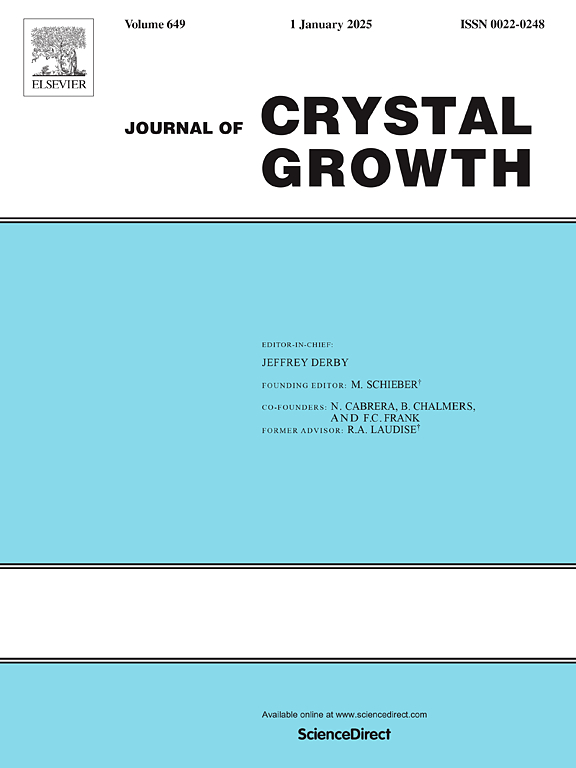Iron-induced low background impurity and high resistivity GaN films grown by MOCVD on patterned sapphire substrates
IF 2
4区 材料科学
Q3 CRYSTALLOGRAPHY
引用次数: 0
Abstract
Electrically insulating GaN epilayers with good crystal quality are essential but challenging for power electronics. Iron (Fe) doping is a valuable method to achieve high resistivity GaN grown by metal–organic chemical vapor deposition (MOCVD). Here, we investigated the impacts of Fe dopants on growth kinetics and electron transition processes in GaN. It is found that the Fe dopants act as surfactants during growth, facilitating the coalescence of GaN and thus effectively limiting the incorporation of oxygen (O) impurities from the substrates into epilayers by 30 times. Meanwhile, the Fe dopants induce a (0/-) transition level, 0.59 eV below the conduction band minimum, which serves as electron traps capturing free electrons and resulting in high resistivity. The relevant mechanism was discussed in detail, and a quantitative model was established, with the consideration of free electron density, donor and Fe concentration, and temperature. Benefit from those, GaN films on patterned sapphire substrates (PSS) with a dislocation density of 1.3 × 108 cm−2, a resistivity up to 7.4 × 109 Ω∙cm, and free of intentional Fe doping at the surface of the epilayer can be achieved. The clarification of Fe dopants in GaN paves the way for future advanced electronic devices and applications.
在图案蓝宝石衬底上MOCVD生长铁致低背景杂质和高电阻率GaN薄膜
具有良好晶体质量的电绝缘GaN涂层是电力电子领域必不可少的,但也是具有挑战性的。铁(Fe)掺杂是金属有机化学气相沉积(MOCVD)制备高电阻率氮化镓的有效方法。本文研究了Fe掺杂剂对GaN生长动力学和电子跃迁过程的影响。研究发现,Fe掺杂剂在生长过程中起到表面活性剂的作用,促进了GaN的聚结,从而有效地将底物中的氧(O)杂质掺入到涂层中,减少了30倍。同时,Fe掺杂剂诱导了一个(0/-)跃迁能级,比导带最小值低0.59 eV,作为捕获自由电子的电子陷阱,导致高电阻率。详细讨论了相关机理,并建立了考虑自由电子密度、给体浓度和Fe浓度、温度等因素的定量模型。得益于这些,可以在图型蓝宝石衬底(PSS)上获得位错密度为1.3 × 108 cm−2,电阻率高达7.4 × 109 Ω∙cm的GaN薄膜,并且可以在脱毛层表面不掺杂有意的Fe。澄清氮化镓中的铁掺杂物为未来先进的电子器件和应用铺平了道路。
本文章由计算机程序翻译,如有差异,请以英文原文为准。
求助全文
约1分钟内获得全文
求助全文
来源期刊

Journal of Crystal Growth
化学-晶体学
CiteScore
3.60
自引率
11.10%
发文量
373
审稿时长
65 days
期刊介绍:
The journal offers a common reference and publication source for workers engaged in research on the experimental and theoretical aspects of crystal growth and its applications, e.g. in devices. Experimental and theoretical contributions are published in the following fields: theory of nucleation and growth, molecular kinetics and transport phenomena, crystallization in viscous media such as polymers and glasses; crystal growth of metals, minerals, semiconductors, superconductors, magnetics, inorganic, organic and biological substances in bulk or as thin films; molecular beam epitaxy, chemical vapor deposition, growth of III-V and II-VI and other semiconductors; characterization of single crystals by physical and chemical methods; apparatus, instrumentation and techniques for crystal growth, and purification methods; multilayer heterostructures and their characterisation with an emphasis on crystal growth and epitaxial aspects of electronic materials. A special feature of the journal is the periodic inclusion of proceedings of symposia and conferences on relevant aspects of crystal growth.
 求助内容:
求助内容: 应助结果提醒方式:
应助结果提醒方式:


